
George Vernon Hudson FRSNZ was a British-born New Zealand entomologist credited with proposing the modern daylight saving time. He was awarded the Hector Memorial Medal in 1923.

Meterana is a genus of moths of the family Noctuidae. This genus is endemic to New Zealand.

Bityla sericea is a species of moth in the family Noctuidae. This species is endemic to New Zealand. It is classified as "At Risk, Naturally Uncommon" by the New Zealand Department of Conservation.
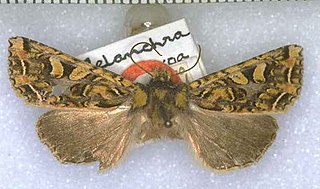
Meterana tetrachroa is a species of moth of the family Noctuidae. This species is endemic to New Zealand. It is classified as "Data Deficient" by the Department of Conservation.

Meterana pictula is a moth of the family Noctuidae. It is endemic to New Zealand. This species has been classified as "At Risk, Declining" by the Department of Conservation.

Meterana pascoei is a moth in the family Noctuidae, endemic to New Zealand. The name and description were published as Morrisonia pascoei by William George Howes in 1912. It is about 38 mm long, with reddish-brown forewings marked with faint lines and a pair of kidney-shaped marks, and a reddish-brown abdomen with a pronounced tuft at the end. Howes named the species in honour of Merlin O. Pasco of Queenstown, who had sent him 20 specimens caught at a treacle-baited moth trap – Howes had previously collected just two specimens, in 1910.
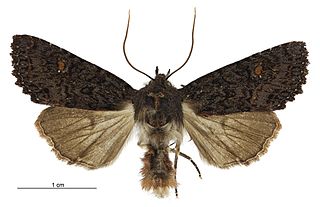
Meterana vitiosa is a moth of the family Noctuidae. It was described by Arthur Gardiner Butler in 1877 from specimens collected by Dr Hector and Mr J. D. Enys in the South Island. It is endemic to New Zealand. The habitat this species prefers consists of forests and shrub-land areas. Adults are on the wing throughout the year.
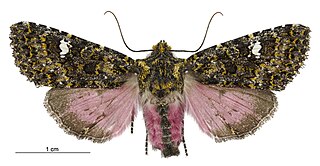
Meterana meyricci, also known as the rose underwing owlet, is a species of moth in the family Noctuidae. It was described and named by George Hampson in 1911 as Miselia meyricci. It is endemic to New Zealand and has been collected in and around Otago. The larvae of this species feed on Pimelea species, including Pimelea poppelwellii. Adults tend to found on the wing during the months of January to March.

Meterana praesignis is a species of moth in the family Noctuidae. It was described by George Howes in 1911 from specimens collected in Orepuki in September and November. It is endemic to New Zealand.

Meterana pansicolor is a species of moth in the family Noctuidae. It is endemic to New Zealand. This species is classified as "At Risk, Naturally Uncommon" by the Department of Conservation.

Meterana ochthistis is a species of moth in the family Noctuidae. It was described by Edward Meyrick in 1887 from specimens obtained in Christchurch. It is endemic to New Zealand.

Meterana exquisita is a species of moth in the family Noctuidae. This species is endemic to New Zealand. It is classified as "At Risk, Relict'" by the Department of Conservation.
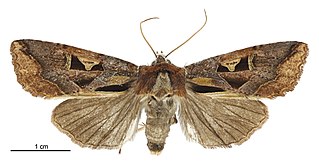
Meterana grandiosa is a species of moth in the family Noctuidae. This species is endemic to New Zealand. It is classified as "At Risk, Relict'" by the Department of Conservation.
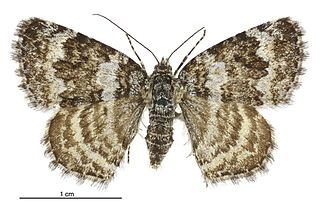
Dasyuris octans is a species of moth in the family Geometridae. It is endemic to New Zealand. This moth is classified as "At Risk, Naturally Uncommon" by the Department of Conservation.

Meterana alcyone is a species of moth in the family Noctuidae, the owlet moths. This species is endemic to New Zealand and is found in the North and South Islands. The larvae of this species feed on the leaves of Muehlenbeckia complexa and Corynocarpus laevigatus. Adults are on the wing every month of the year except January. They are attracted to light and have also been recorded as bycatch in the New Zealand National Fruit Fly Surveillance fly traps.

Meterana asterope is a species of moth in the family Noctuidae. This species is endemic to New Zealand and is found in the North and South Islands. It inhabits both native forest and open habitat and adults emerge during the New Zealand summer. Adults are on the wing in December and January. This species is attracted to light and has also been collected via sugar traps.
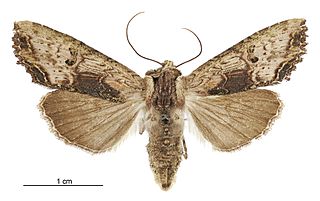
Meterana coeleno is a species of moth in the family Noctuidae. This species is endemic to New Zealand.

Meterana diatmeta is a species of moth in the family Noctuidae. This species is endemic to New Zealand.

Meterana merope, also known as the Patē Owlet, is a species of moth in the family Noctuidae. This species is endemic to New Zealand. The larvae of this species feed on pāte.



















